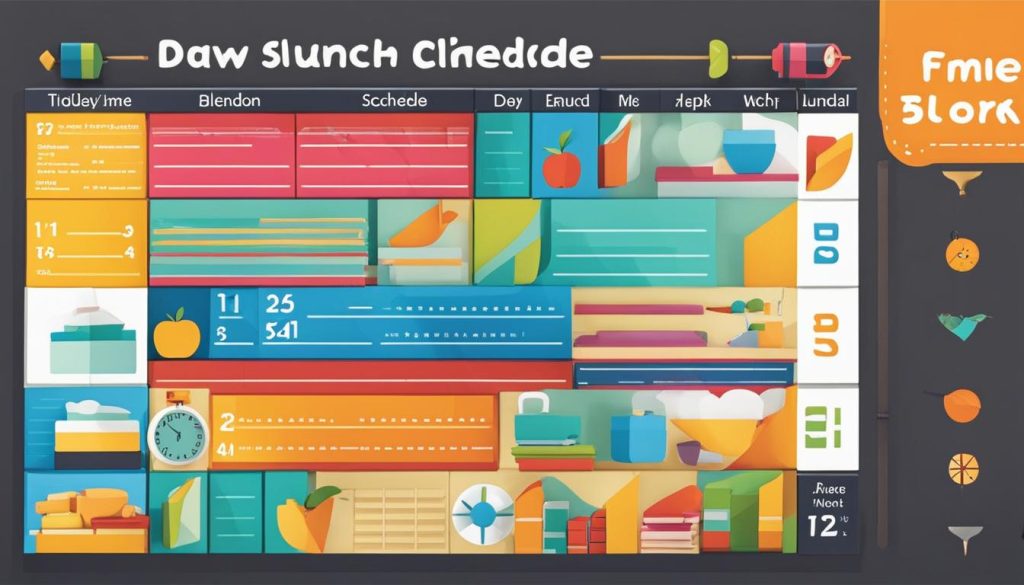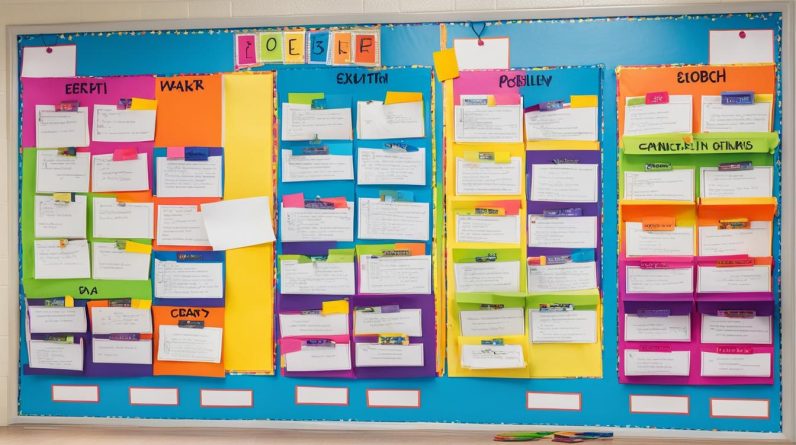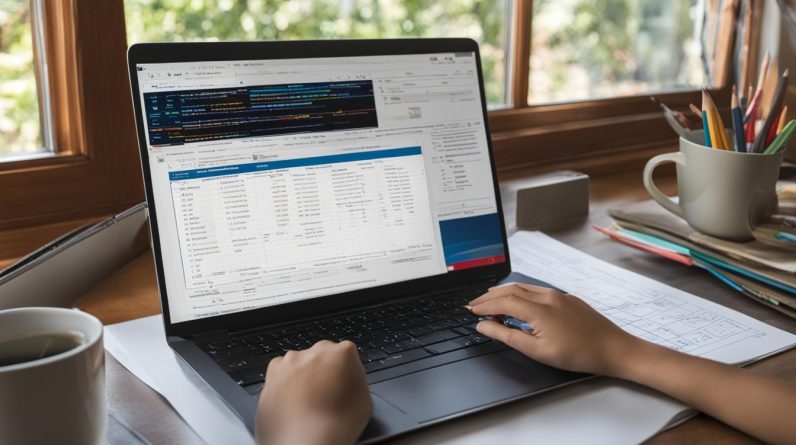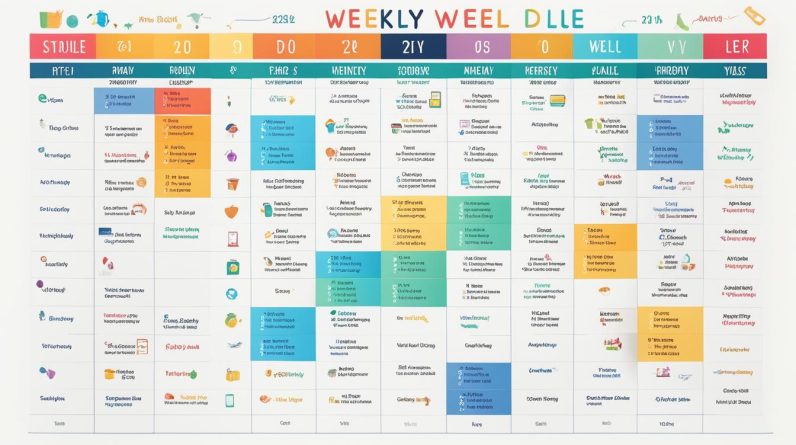Are you an in-home schooling teacher, homeschooling teacher, or private tutor? As more parents embrace personalized education and one-on-one instruction, the demand for educators who excel in home-based learning has grown. In this guide, we will provide you with valuable tips and strategies to create a successful learning environment tailored to the needs of your students.
With the increasing number of students receiving education at home, it is crucial to design a tailored curriculum and provide individualized teaching to ensure academic success. Whether you are an experienced educator or new to teaching in a home-based setting, this article will equip you with the necessary tools and knowledge to thrive in this educational landscape.
Key Takeaways:
- Create a designated learning space to promote organization and minimize distractions.
- Follow a daily schedule to provide structure and maintain focus.
- Map out the school year ahead of time to track progress and visualize goals.
- Set learning goals together with your students using the SMART formula.
- Take learning beyond the classroom by incorporating experiential activities and practical skills.
Create a Designated Learning Space
To avoid disorganization and chaos, it is important to create a designated learning space for your children. This designated learning space will provide a dedicated area for them to focus on their studies and engage in productive learning activities. By having a specific area for learning, you can create an environment that promotes concentration and minimizes distractions.
Start by selecting a quiet and well-lit area in your home that can serve as the designated learning space. This could be a spare room, a corner of the living room, or even a dedicated study area. Ensure that the space is free from clutter and has enough room for your child to spread out their study materials.
“A designated learning space enhances focus and minimizes distractions.”
| Benefits of a Designated Learning Space | Tips for Organizing the Space |
|---|---|
|
|
“A well-organized learning space promotes productivity and reduces stress.”
Once you have established the designated learning space, it is important to organize study materials and resources. Keep essential items such as textbooks, notebooks, and stationery readily accessible to your child. Consider using folders, binders, or containers to keep materials organized and easily identifiable.
Additionally, having a printed schedule displayed at the learning hub can greatly assist your child in staying organized and on track. This schedule should outline tasks that need to be completed and indicate any upcoming deadlines or important dates. By visually displaying their daily or weekly goals, your child will have a clear understanding of what needs to be accomplished.
“An organized learning space fosters a sense of responsibility and accountability.”
Creating a designated learning space not only provides structure but also helps to establish a mindset for learning. By setting aside a specific area for education, you are sending a clear message to your child that learning is a priority. With an organized and well-equipped learning environment, your child can thrive academically and develop good study habits.
Follow a daily schedule
Creating and following a daily schedule is crucial for homeschooling success. A well-structured routine helps you and your child stay focused and organized. Here are some tips to help you create an effective daily schedule:
- Be flexible: One of the advantages of homeschooling is the flexibility it offers. Tailor your daily schedule to accommodate your child’s individual needs and interests. Allow for breaks, outdoor activities, and time for exploration.
- Color-code your activities: Visual cues can make your schedule more engaging and easier to follow. Assign different colors to subjects or activities, making it visually appealing and helping your child to quickly identify what they need to do.
- Use swimlanes: If you have multiple children or need to track different schedules, consider using swimlanes. These horizontal lanes allow you to organize each child’s activities, ensuring everyone’s tasks are clearly defined.
- Create a flowchart: A flowchart can provide a visual representation of your daily routine. Use arrows and boxes to outline the sequence of activities, allowing you and your child to easily see what comes next.
By following a daily schedule and incorporating these organization techniques, you can create a structured and efficient learning environment for your homeschooling journey.

Illustration depicts a color-coded daily schedule with swimlanes and a flowchart.
Map out the school year ahead of time
Mapping out the school year ahead of time is a crucial step in effective homeschool planning. By creating a well-structured roadmap for the academic year, you can track progress, stay organized, and ensure that you cover all necessary topics and skills.
To start, consider using curriculum mapping techniques to outline the subjects and content you plan to teach throughout the year. This involves breaking down the curriculum into manageable units or topics, aligning them with specific timeframes or periods.
One useful tool for curriculum mapping is the org chart. This visual representation allows you to see the flow of topics and how they connect to one another, providing a clear overview of the entire school year.
In addition to curriculum mapping, progress tracking is essential for measuring your child’s development and identifying areas that may need additional attention. By visualizing goals and tracking progress, you can celebrate achievements, address challenges, and refine your teaching strategies to better meet your child’s needs.

A flowchart or mind map can be excellent tools for visualizing goals and progress. You can use a flowchart to map out the key milestones or learning objectives for each subject, allowing you to see how each goal relates to the overall progression of the school year. A mind map, on the other hand, enables you to explore the interconnectedness of different concepts and topics.
Below is an example of a simple curriculum mapping flowchart:
| Subject | Unit | Skills/Topics |
|---|---|---|
| Math | Addition and Subtraction | Addition with regrouping, subtraction with borrowing, word problems |
| Science | Life Cycle | Plants, animals, metamorphosis, reproduction |
| Language Arts | Reading Comprehension | Text analysis, inference, summarizing, vocabulary |
| History | American Revolution | Causes, key figures, events, impact |
By visualizing your curriculum in this way, you can ensure comprehensive coverage, stay on track, and easily adapt your plans as needed.
When mapping out the school year, take into account any holidays, breaks, or special events that may impact the schedule. This flexibility will allow you to adjust your pacing and make room for additional activities, field trips, or projects.
Remember, mapping out the school year ahead of time is not about rigidly adhering to a predetermined plan, but rather about providing a framework to guide your teaching journey. Stay flexible, remain open to adjustments, and be responsive to your child’s unique learning needs.
Set Learning Goals Together
Setting learning goals together with your child is an essential aspect of personalized education. By involving your child in the goal-setting process, you can create a customized learning plan that aligns with their interests and aspirations. This collaborative approach empowers your child to take ownership of their education and promotes a sense of responsibility.
When setting learning goals, it is important to consider both short-term and long-term objectives. Short-term goals provide immediate targets that can be achieved within a reasonable timeframe, while long-term goals set a broader vision for your child’s academic journey.
Here are some tips for setting effective learning goals:
- Discuss your child’s interests and passions: Start the goal-setting process by having open conversations with your child about their interests, passions, and areas of curiosity. Understanding their unique preferences will help you align their learning goals with their intrinsic motivation.
- Consider state or national requirements: It is important to be aware of the educational standards set by your state or country. Incorporate these requirements as foundational milestones to ensure that your child’s education remains well-rounded and prepares them for future academic pursuits.
- Use the SMART formula: The SMART formula is a widely-used framework for setting goals. Each goal should be Specific, Measurable, Achievable, Relevant, and Time-bound. By following this formula, you can create clear and actionable learning goals.
“Setting goals is the first step in turning the invisible into the visible.” – Tony Robbins
Involving your child in the goal-setting process fosters a sense of ownership and motivation in their education. It also allows them to contribute their own ideas and aspirations, making the learning experience more engaging and meaningful.
Take learning beyond the classroom
Homeschooling offers the flexibility to learn beyond the traditional classroom setting. You have the opportunity to engage in various activities that can enhance the learning experience and provide a well-rounded curriculum. By exploring new skills and engaging in experiential learning, you can make education more practical, engaging, and enjoyable.
Board Games
Board games are an excellent way to combine entertainment with learning. They promote critical thinking, problem-solving, strategy development, and collaboration. Plus, they offer a break from textbooks and worksheets, making learning more interactive and engaging.
Cooking
Cooking is a practical skill that can be incorporated into homeschooling. It helps children understand science, math, and culture while improving their creativity and independence. Cooking together also provides an opportunity for bonding and family time.
Practical Skills
While focusing on academic subjects, don’t forget to teach practical skills that will be valuable in everyday life. Teach your children how to manage household tasks, such as budgeting, organizing, and problem-solving. These skills will prepare them for independence in the future.
Exploring New Skills
Encourage your children to explore their interests and passions by trying out various activities. Whether it’s learning a musical instrument, painting, coding, or gardening, exploring new skills broadens their horizons and promotes personal growth.
“Experiential learning allows children to apply what they have learned in real-life situations, making the learning process more meaningful and memorable.”
Incorporating these activities into your homeschooling routine not only makes learning more enjoyable but also helps children develop practical skills and a well-rounded education.

| Benefits of Taking Learning Beyond the Classroom |
|---|
| Enhances critical thinking and problem-solving skills |
| Promotes creativity and exploration |
| Fosters independence and self-reliance |
| Creates memorable experiences |
| Instills practical skills for everyday life |
Make Learning a Family Activity
Involving the whole family in learning makes it more enjoyable and fosters a sense of togetherness. By engaging in educational activities as a family, you not only create lasting memories but also provide a rich learning experience for everyone involved.
One way to make learning a family activity is by reading together. Choose books that cater to the interests and age levels of each family member. Take turns reading aloud or designate specific times for quiet reading sessions. Reading together not only improves literacy but also sparks discussions and stimulates critical thinking.
Another way to involve the family in learning is by exploring hobbies. Encourage each family member to pursue their interests and hobbies. Whether it’s painting, playing a musical instrument, or gardening, these activities provide opportunities for learning and self-expression. Dedicate time for family members to share their skills and knowledge with one another, fostering a supportive and learning-oriented environment.
Engaging in crafts is another enjoyable way to make learning a family affair. From simple art projects to DIY science experiments, crafting sparks creativity and problem-solving skills. Family members can collaborate on projects, exchange ideas, and learn from one another. Crafting together promotes teamwork and encourages individual expression.
Don’t forget to take advantage of local outings to enhance the learning experience. Explore museums, parks, historical sites, and other cultural attractions in your area. These outings provide hands-on learning opportunities and expose the family to new experiences and perspectives. Encourage family members to take turns planning and organizing these outings, allowing each person to contribute and expand their knowledge.
Remember, making learning a family activity creates a positive and engaging environment that nurtures curiosity and fosters a love for lifelong learning.

Benefits of Family Involvement in Learning
- Promotes strong family bonds
- Enhances communication skills
- Fosters a love for learning
- Stimulates critical thinking
- Nurtures creativity and self-expression
- Builds teamwork and collaboration
- Expands knowledge and cultural awareness
- Provides memorable and enjoyable educational experiences
Collaborate with Other Homeschoolers
Connecting with other homeschoolers in your area or online can provide a wealth of support, resources, and educational opportunities. Building relationships within homeschooling communities not only enriches the educational experience for both parents and children but also fosters a sense of belonging and camaraderie.
One of the biggest advantages of joining homeschooling communities is the opportunity for resource sharing. By connecting with other homeschooling families, you can exchange ideas, materials, and teaching strategies. Collaborative efforts like co-op classes, study groups, and field trips can bring diverse perspectives and expertise to your homeschooling journey.
In addition to resource sharing, homeschooling communities offer numerous educational opportunities. Many communities organize educational events, workshops, and seminars where homeschoolers can learn from experts in various fields. These events often cover a wide range of subjects, allowing your child to explore new interests and gain a comprehensive education.
Furthermore, homeschooling communities provide a platform for socialization and peer interaction. Through group activities, park days, and community events, your child can develop friendships with other homeschoolers, fostering a sense of belonging and creating a supportive social network.
Remember, homeschooling is not meant to be an isolated journey. By collaborating with other homeschoolers, you can tap into a wealth of resources, support, and educational opportunities, enriching your child’s learning experience.
| Benefits | Description |
|---|---|
| Resource Sharing | Exchange ideas, materials, and teaching strategies with other homeschoolers |
| Educational Opportunities | Participate in educational events, workshops, and seminars organized by homeschooling communities |
| Socialization | Connect with other homeschoolers for group activities and socialization opportunities |
Ease into school
When embarking on the homeschooling journey, it’s important to ease into the full curriculum gradually. Starting with fewer subjects allows both you and your child to adjust to the homeschool environment and build a natural routine. By taking small steps, you can ensure a smooth transition and set the foundation for a successful learning experience.
Experiment with learning styles and schedules:
Every child learns differently, and it’s essential to discover the most effective learning styles that work for your child. Experiment with different approaches such as visual, auditory, kinesthetic, or a combination of these. Additionally, try out different schedules and find the one that best suits your child’s energy levels and concentration span. Flexibility is key during this initial phase.
Adapt based on individual needs:
Each child has unique strengths, weaknesses, and interests. As you ease into the homeschool curriculum, pay close attention to your child’s individual needs and adapt accordingly. Tailor the learning experience to meet their specific requirements and match their pace of learning. This personalized approach will enable them to thrive academically and develop a lifelong love for learning.
Tips for Gradual Transition
- Start by introducing one or two subjects and gradually add more over time.
- Allow ample time for review and reinforcement of concepts before moving on to new topics.
- Encourage breaks and physical activity to keep your child engaged and focused.
- Monitor your child’s progress closely and make adjustments as needed.
- Communicate regularly with your child to address any concerns or challenges they may be facing.
| Benefits of a gradual transition | Tips for success |
|---|---|
| Reduces overwhelm and stress | Monitor your child’s progress closely |
| Allows for a smoother adjustment period | Encourage breaks and physical activity |
| Enables personalized attention and support | Communicate regularly with your child |
Utilize free homeschooling resources
When it comes to homeschooling, parents and students have access to an abundance of free resources that can enhance the learning experience. These resources provide valuable support, materials, and tools to create a successful and engaging homeschool environment.
One such resource that can greatly benefit homeschooling families is Lucidchart. Lucidchart is an online platform that offers a variety of features to help with scheduling and organization. Its user-friendly interface allows you to create visual schedules, track assignments, and manage your homeschooling tasks effectively.
With Lucidchart, you can design customized schedules that cater to your child’s individual needs. Whether you prefer a daily, weekly, or monthly schedule, you can easily create and modify it according to your homeschooling goals. By visualizing the routine, you can ensure a well-structured and productive learning environment.
Tracking assignments is made simple with Lucidchart’s intuitive interface. You can easily add and update tasks, set deadlines, and monitor progress. This feature helps both parents and students stay organized and on top of their homeschooling workload.
Moreover, Lucidchart offers collaborative features that allow parents and students to work together in real-time. This can be particularly useful for parents who have multiple children with different schedules and subjects. By utilizing Lucidchart, you can ensure effective communication and coordination within your homeschooling routine.
Don’t miss out on the valuable homeschooling resources available to you. Take advantage of Lucidchart’s user-friendly features for scheduling and organization to create a well-structured and efficient homeschooling environment.
Conclusion
Homeschooling can be a rewarding and personalized educational experience for children and parents. By implementing organization strategies, setting goals, involving the family, collaborating with other homeschoolers, and utilizing resources, parents can create a successful in-home learning environment tailored to their child’s individual needs and interests.
Organizing a homeschool learning space and following a daily schedule provides the necessary structure for effective learning. Mapping out the school year ahead of time allows for progress tracking and visualizing goals. Setting learning goals together with your child ensures a personalized education that aligns with state or national requirements.
Engaging in experiential learning, involving the whole family, and collaborating with other homeschoolers enriches the educational experience. Gradually easing into the curriculum and adapting to individual needs helps in building a natural routine. Additionally, utilizing free homeschooling resources like Lucidchart for scheduling and organization enhances the homeschooling journey.
Homeschooling empowers parents to provide a tailored education that nurtures their child’s unique abilities and interests. With dedication, creativity, and a supportive community, parents can create a successful in-home learning environment that fosters academic growth and personal development.
FAQ
How do I create a designated learning space?
Choose a specific area where your children can keep their supplies and books. This will help create an organized learning environment.
Why is it important to follow a daily schedule?
Following a daily schedule provides structure and helps maintain focus. It can be helpful to color-code activities, use swimlanes, or create flowcharts to visualize and organize the daily routine.
How can I map out the school year?
Mapping out the school year allows you to track progress and break down big goals into manageable steps. Tools like org charts, mind maps, roadmaps, and flowcharts can help you visualize and stay organized throughout the year.
How can I set learning goals for my child?
Setting learning goals together with your child allows for customization and direction in their education. You can outline key learning objectives based on state or national requirements and involve your child in the goal-setting process using the SMART formula.
How can I take learning beyond the classroom?
Homeschooling offers the flexibility to learn beyond the traditional classroom setting. Engaging in activities like board games, cooking, household management, writing emails, visiting local businesses, and libraries can enhance the learning experience and provide a well-rounded curriculum.
Why should I involve the whole family in learning?
Involving the whole family in learning makes it more enjoyable. Activities like reading together, exploring hobbies, making crafts, going on local outings, and engaging in interactive learning experiences create a fun and memorable educational experience.
How can I collaborate with other homeschoolers?
Connecting with other homeschoolers in your area or online can provide support, resources, and opportunities for collaboration. Building relationships within the homeschooling community enriches the educational experience for both parents and children.
How do I ease into homeschooling?
Gradually easing into the full curriculum by starting with fewer subjects and allowing time to acclimate to the homeschool environment helps in building a natural routine. It is essential to experiment with learning styles and schedules and adapt based on individual needs.
Where can I find free homeschooling resources?
There are numerous free homeschooling resources available for parents and students. One useful tool is Lucidchart, which can be used for visualizing schedules, tracking assignments, and staying organized throughout the homeschooling journey.






